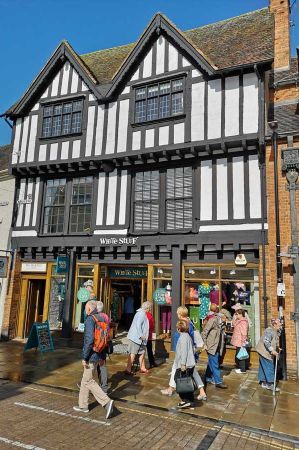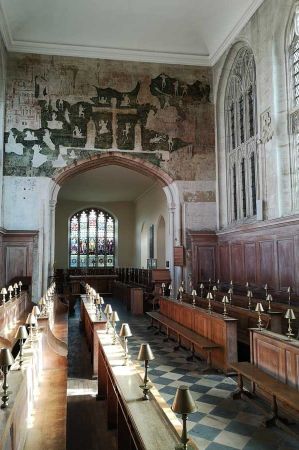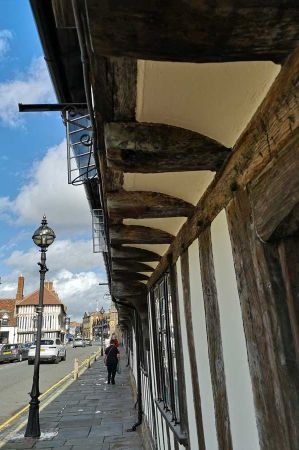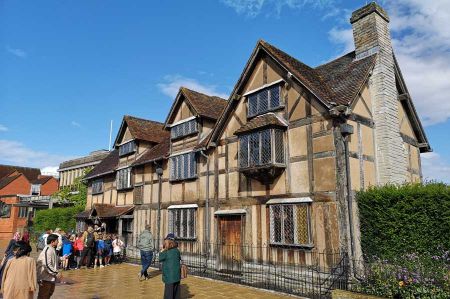Stratford-upon-Avon - just Shakespeare's birthplace?
- Written by Portal Editor
Stratford-upon-Avon - Although rainy and windy, the English lessons about the city Stratford-upon-Avon as the birthplace of Shakespeare still in mind, we were tempted to drive to the city, despite the warning of tourist flows from the Far East.
Already at that time we had learned that the name Stratford-upon-Avon was a combination of the Old English stream and the Latin stratum meaning "road", better ford, indicating the flat part of a river that can be crossed with the cart or on foot. Avon is the Celtic word for river. This ford or road was once part of a Roman road that connected Icknield Street in Alcester with the Fosse Way. The ford, which thus served as an intersection since Roman times, later became the location of the Clopton Bridge. A historically documented survey from 1251 to 1252 used the name Stratford for the first time to identify Old Stratford and the newer mansions. The name Stratford was always used after this time to describe the area specifically around the Trinity Church and the street of the old town.
Early history of development of Stratford-upon-Avon
 The first settlements, later known as Stratford, originated after the invasion of Warwickshire by the Anglo-Saxons in the 7th century. The land was owned by the Church of Worcester and remained a village until the end of the 12th century, when it was turned into a first town by Lord John of Coutances. John of Coutances presented a new city plan based on a grid system to expand Stratford and allow people to rent houses and shops to trade within the city in 1196. In addition, in 1196, King Richard I bestowed a charter on Stratford-upon-Avon, which allowed for the organization of a weekly market in the city, giving it the status of a market town. These two documents, which formed the basis for transforming Stratford from a village into a city, ultimately ensured that the city of Stratford was already celebrating its 800th birthday.
The first settlements, later known as Stratford, originated after the invasion of Warwickshire by the Anglo-Saxons in the 7th century. The land was owned by the Church of Worcester and remained a village until the end of the 12th century, when it was turned into a first town by Lord John of Coutances. John of Coutances presented a new city plan based on a grid system to expand Stratford and allow people to rent houses and shops to trade within the city in 1196. In addition, in 1196, King Richard I bestowed a charter on Stratford-upon-Avon, which allowed for the organization of a weekly market in the city, giving it the status of a market town. These two documents, which formed the basis for transforming Stratford from a village into a city, ultimately ensured that the city of Stratford was already celebrating its 800th birthday.
John's of Coutance's plans to turn Stratford into a city meant that Stratford became a place of work and turnover for traders and merchants. By 1252, the city had about 240 citizens, as well as shops, stalls and other buildings. Stratford's new workers formed a guild known as the Guild of the Holy Cross for their business and religious needs.
any of the city's earliest and most important buildings are located on the so-called historic spine of Stratford-upon-Avon, which was once the main route from the city center to the parish church.
The construction of Clopton Bridge made trade flourish in Stratford-upon-Avon
 The historic spine route begins at Shakespeare's birthplace on Henley Street. Continue through Henley Street to the top of Bridge Street and then into High Street, home to many Elizabethan buildings, including Harvard House. The route continues through Chapel Street, where Nash's House and New Place are located. The historic backbone runs along Church Street, where there are 15th-century guild buildings and 18th and 19th-century buildings. The route then ends in the Old Town, which includes Hall's Croft and Holy Trinity Church.
The historic spine route begins at Shakespeare's birthplace on Henley Street. Continue through Henley Street to the top of Bridge Street and then into High Street, home to many Elizabethan buildings, including Harvard House. The route continues through Chapel Street, where Nash's House and New Place are located. The historic backbone runs along Church Street, where there are 15th-century guild buildings and 18th and 19th-century buildings. The route then ends in the Old Town, which includes Hall's Croft and Holy Trinity Church.
During Stratford's early expansion into the city, the only access across the River Avon into and out of town was a wooden bridge, which is believed to have been built in 1318. However, the bridge could not be crossed at times when the river was rising and flooding the bridge. The antiquarian John Leland described the condition even then as "a poor bridge of wood and no dam there", which is why many poor people and especially the nobility refused to come to Stratford. In 1480, a new brick arch bridge was built in place of the Clopton Bridge, named after Hugh Clopton, who paid for the construction. The new bridge made it easier for people to trade in Stratford-upon-Avon and the passers-by to come in the city.
The Cotswolds near Stratford were an important sheep production area until the end of the 19th century. Stratford was one of the main processing, marketing and distribution centers for sheep and wool. As a result, Stratford also became a tanning center in the 15th-17th centuries. Both the river and the ancient Roman road served as trade routes for the city.
Due to Shakespeare - today one of the tourist centers
 Although Stratford-upon-Avon trade increased, it grew barely between the mid-13th and the late 16th century. According to a survey in the city in 1590, 217 houses belonged to the mansions of the 17th century, hearth tax declarations show that there were no more than 429 houses in the city until 1670. However, after several enclosure laws in the late 18th century, a more substantial expansion began, with John Payton's first and greatest development cultivating land. Several streets are being built on the north side of the old town, including John Street and Payton Street. Prior to road and rail dominance, Stratford was the gateway to the British Channel network.
Although Stratford-upon-Avon trade increased, it grew barely between the mid-13th and the late 16th century. According to a survey in the city in 1590, 217 houses belonged to the mansions of the 17th century, hearth tax declarations show that there were no more than 429 houses in the city until 1670. However, after several enclosure laws in the late 18th century, a more substantial expansion began, with John Payton's first and greatest development cultivating land. Several streets are being built on the north side of the old town, including John Street and Payton Street. Prior to road and rail dominance, Stratford was the gateway to the British Channel network.
In 1769, actor David Garrick staged a major Shakespeare jubilee on three days, during which a large rotunda was build and many visitors came. This contributed to the growing phenomenon of bardolatry, which has made Stratford a steadily growing tourist destination.
Please read as well:
Narrowboat in Stratford upon Avon - Living on the water
A first visit to Norwich - and it will not be last one
-
 Hike through Stratford upon Avon
Hike through Stratford upon Avon
Hike through Stratford upon Avon
Hike through Stratford upon Avon
-
 Hike through Stratford upon Avon
Hike through Stratford upon Avon
Hike through Stratford upon Avon
Hike through Stratford upon Avon
-
 Hike through Stratford upon Avon
Hike through Stratford upon Avon
Hike through Stratford upon Avon
Hike through Stratford upon Avon
-
 Hike through Stratford upon Avon
Hike through Stratford upon Avon
Hike through Stratford upon Avon
Hike through Stratford upon Avon
-
 Hike through Stratford upon Avon
Hike through Stratford upon Avon
Hike through Stratford upon Avon
Hike through Stratford upon Avon
-
 Hike through Stratford upon Avon
Hike through Stratford upon Avon
Hike through Stratford upon Avon
Hike through Stratford upon Avon
-
 Hike through Stratford upon Avon
Hike through Stratford upon Avon
Hike through Stratford upon Avon
Hike through Stratford upon Avon
-
 Hike through Stratford upon Avon
Hike through Stratford upon Avon
Hike through Stratford upon Avon
Hike through Stratford upon Avon
-
 Hike through Stratford upon Avon
Hike through Stratford upon Avon
Hike through Stratford upon Avon
Hike through Stratford upon Avon
-
 Hike through Stratford upon Avon
Hike through Stratford upon Avon
Hike through Stratford upon Avon
Hike through Stratford upon Avon
-
 Hike through Stratford upon Avon
Hike through Stratford upon Avon
Hike through Stratford upon Avon
Hike through Stratford upon Avon
-
 Hike through Stratford upon Avon
Hike through Stratford upon Avon
Hike through Stratford upon Avon
Hike through Stratford upon Avon
-
 Hike through Stratford upon Avon
Hike through Stratford upon Avon
Hike through Stratford upon Avon
Hike through Stratford upon Avon
-
 Hike through Stratford upon Avon
Hike through Stratford upon Avon
Hike through Stratford upon Avon
Hike through Stratford upon Avon
-
 Hike through Stratford upon Avon
Hike through Stratford upon Avon
Hike through Stratford upon Avon
Hike through Stratford upon Avon
-
 Hike through Stratford upon Avon
Hike through Stratford upon Avon
Hike through Stratford upon Avon
Hike through Stratford upon Avon
-
 Hike through Stratford upon Avon
Hike through Stratford upon Avon
Hike through Stratford upon Avon
Hike through Stratford upon Avon
-
 Hike through Stratford upon Avon
Hike through Stratford upon Avon
Hike through Stratford upon Avon
Hike through Stratford upon Avon
-
 Hike through Stratford upon Avon
Hike through Stratford upon Avon
Hike through Stratford upon Avon
Hike through Stratford upon Avon
-
 Hike through Stratford upon Avon
Hike through Stratford upon Avon
Hike through Stratford upon Avon
Hike through Stratford upon Avon
-
 Hike through Stratford upon Avon
Hike through Stratford upon Avon
Hike through Stratford upon Avon
Hike through Stratford upon Avon
-
 Hike through Stratford upon Avon
Hike through Stratford upon Avon
Hike through Stratford upon Avon
Hike through Stratford upon Avon
-
 Hike through Stratford upon Avon
Hike through Stratford upon Avon
Hike through Stratford upon Avon
Hike through Stratford upon Avon
-
 Hike through Stratford upon Avon
Hike through Stratford upon Avon
Hike through Stratford upon Avon
Hike through Stratford upon Avon
https://www.alaturka.info/en/great-britain/derbyshire/382-norfolk/4999-stratford-upon-avon-more-than-just-shakespeare-s-birthplace#sigProIdb0d6213096

